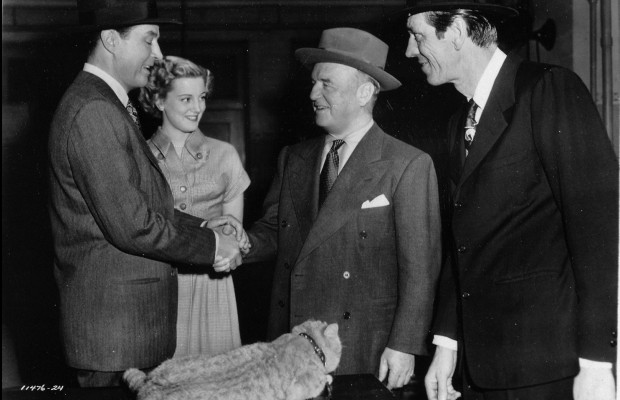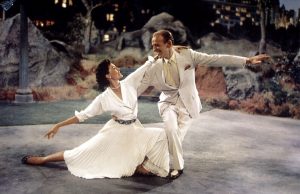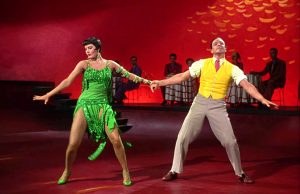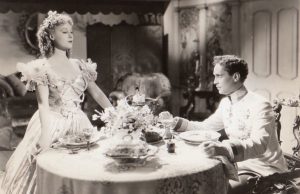Rhubarb (1951)
By Toronto Film Society on November 30, 2015
Toronto Film Society presented Rhubarb (1951) on Monday, December 12, 1977 in a double bill with Come and Get It as part of the Season 30 Monday Evening Film Buff Series, Programme 3.
Production Company: Paramount. Producers: William Perlberg and George Seaton. Director: Arthur Lubin. Screenplay: Dorothy Reid and Frances Cockrell, based on the novel by H. Allen Smith. Photography: Lionel Lindon. Editor: Alma Macrorie. Art Direction: Hal Pereira, Henry Bumstead. Music: Van Cleave.
Cast: Ray Milland (Eric Yeager), Jan Sterling (Polly), Gene Lockhart (T.J. Banner), William Frawley (Len Sicles), Elsie Holmes (Myra Banner), Taylor Holmes (P. Duncan Munk), Willard Waterma (Orlando Dill), Henry Slate (Dud Logan), James Hayward (Doom), Anthony Redecki (First Ballplayer), Leonard Nimoy (Second Ballplayer), James J. Griffith (Oggie Meadows).
For as long as cinema has existed, animals have appeared on the screen. There have been many successful films with a number of canine stars, Rin-Tin-Tin, Lassie, Asta, co-star in the Thin Man series, all inveterate scene-stealers, to name some of the most celebrated. Horses have also had their share of star status, Black Beauty, National Velvet, Smoky, the Flicka films, not to mention the performing Trigger. Cats, on the other hand, are often dragged about as if they were inanimate objects. They hardly ever look happy on the screen. The white Persian in Stroheim’s Queen Kelly is a classic example; like all those pulled around by glamorous women for ornamental effect, he was, in fact, a picture of misery. Doubtless because of superstition, many are presented as sinister figures. Cats have long been used, as the late Walt Disney notes in Robert Fields’ book on his art, “to symbolize evil,” and nowhere, of course, more persistently than in animated cartoons, whether by his own or other companies. Alone among domestic animals to have retained their spirit of independence, cats do not willingly submit or enjoy performing. It is perhaps useless, not to say unkind, to subject them to studio discipline and probably the best way to get satisfactory portrayals, showing their intelligence, delicacy and dignity, is to film them like wild animals in documentary, that is, in congenial surroundings and with sympathetic understanding.
One of the few films in which a cat has had to play a leading role, is Rhubarb, and director, Arthur Lubin, (of Francis, the talking mule fame), has managed to get a very winning performance indeed. Paramount’s cat has it all over Universal’s rhetorical jackass, Francis, being an animal content to grin wickedly and more or less keep his mouth shut. He is not your usual run-of-the-mill house pet. The furry protagonist of H. Allen Smith’s comic novel was a snarling, spitting tom whose fighting spirit so appealed to a hard-headed millionaire that he willed the animal no less than $30,000,000, plus a Baseball team called the Brooklyn Loons. Although Paramount’s cat is a bit toned down from the scrappy protagonist of Smith’s novel, he is certainly one of the most winningly aggressive heros ever to slink out of an alley.
Dorothy Reid and Frances Cockrell, the scenarists, have stuck closely to the story, and passed on some of Mr. Smith’s snappiest lines to the cast, who respond sportingly. Ray Milland is the energetic, slightly sheepish, guardian of the hero. Jan Sterling is good as his sweetheart, who combats an allergy to Rhubarb, and Gene Luckhart, William Frawley, Elsie Holmes and a colourfully battered assortment of Damon Runyon types do very nicely in minor roles.
The director, Arthur Lubin, is certainly one of Hollywood’s best judges of public taste. His Abbott and Costello comedies, Francis the talking mule films, and Mr. Ed television series were immensely successful. Perhaps more choosy viewers may have a difference of opinion about that but Lubin feels that of his sixty-nine or so films, only “eight have been miserable flops,” which is a very good record indeed. In a 1973 interview with Charles Flynn and Todd McCarthy, he states, “They try to spot a director out here (Hollywood), put him in a category. He’s drama, he’s this, he’s that. And, at the moment, I’m an animal director. Unfortunately. Because I wanted to do a picture last year at MGM that I thought I was right for. And they told my agent, ‘No, no, it’s not for Lubin. There are no animals in it.'” He supposes having done five mule pictures and six years of Mr. Ed, it’s natural he would be classified that way. At the time of the interview he was involved in a pilot series about a cat, based on his earlier film Rhubarb. He admits, “I know, once I start that, they’ll lsay, ‘There goes Lubin with his animals again.’ But I say, ‘Well, it pays well!'”
Notes written and compiled by Barry Chapman
Kings of the Bs, ed. Todd McCarthy & Charles Flynn, Dutton Paperback, 1975
Animals and the Cinema by Catherine De La Roche, Sight and Sound, Summer, 1955
New York Times, Review by Howard Thompson, August 31, 1951
You may also like...
-
News

Frances Blau
Toronto Film Society | February 27, 2024On Monday, February 26th, 2024, Toronto Film Society lost longtime friend, supporter, and board member Frances Blau. Known for her sense of humour, her love of film, her generosity,...
-
Special Events

Monday Evening Film Noir Double Bill at the Paradise Theatre
Toronto Film Society | July 8, 2024The Toronto Film Society presents a film-noir double feature at one low price! The Window (1949) in a double bill with Black Angel (1946) at the Paradise Theatre on Monday, August...
Programming

Virtual Saturday Night at the Movies
Toronto Film Society | July 20, 2024Toronto Film Society is back in the theatre! However, we’re still pleased to continue to bring you films straight to your home! Beginning Season 73 until now we have...
4-
 Toronto Film Society | July 8, 2024
Toronto Film Society | July 8, 2024
Monday Evening Film Noir Double Bill at the Paradise Theatre
-
 Toronto Film Society | November 6, 2022
Toronto Film Society | November 6, 2022
-
 Toronto Film Society | August 1, 2023
Toronto Film Society | August 1, 2023
Donate to Toronto Film Society – We’re now a Registered Charity!
-
Copyright © 2017 Toronto Film Society.






Leave a Reply